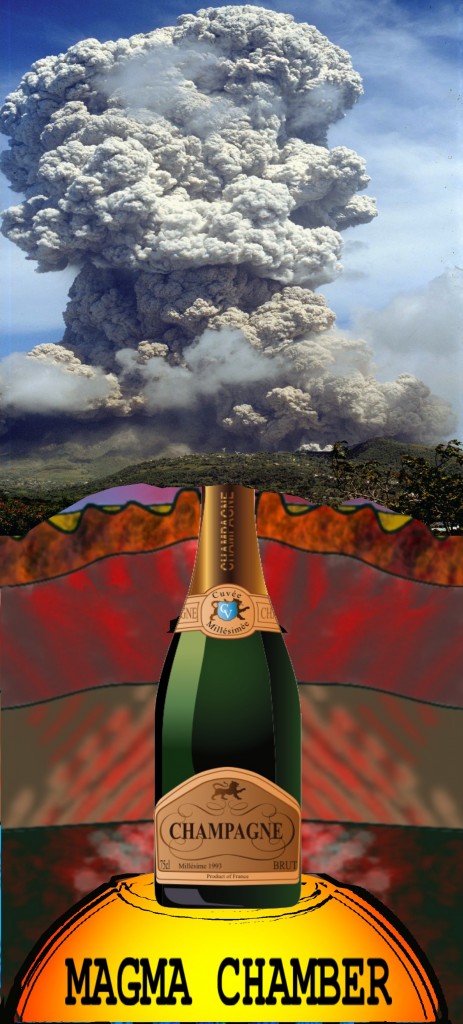23 December 2010
Volcanic eruptions, like popping the cork on a magnum of champagne
Posted by mohi

Imagine a champagne bottle 5 kilometers tall; volcanologists do. A conceptual model of the Soufriere Hills Volcano in Montserrat. Photo illustration by Keith Rozendal, after Hautmann et al., (2009). Tectonophysics, 471, 87-95. Images sources: openclipart.org/National Science Foundation photo/commons.wikimedia.org
The holiday dinner of the Northern California Science Writers Association may explain why I have wine on my mind, but the image obsesses AGU volcanologists too, as I learned in two sessions (V33D & V44C) at last week’s AGU Fall Meeting.
Geophysicist Oleg Melnik of Moscow State University and the University of Bristol ended his discussion of explosive volcano chemistry and physics with a comic illustration of him pulling a cork from an exploding volcano. But don’t volcanoes uncork themselves? I thought champagne provided a more apt metaphor, and I don’t think I’m distorting the science much to say explosive volcanoes pop like this favorite sparkling adult beverage.
Melnik and his University of Bristol-based collaborator Stephen Sparks both discussed the typical manner in which volcanoes get inaccurately portrayed as a large blob of a magma chamber topped by a “soda straw” column of magma leading to the surface. These scientists argue that failing to consider the true shape of a volcano’s magma supply system delayed the understanding of how these mountains blow their tops and how regularly such threats occur.
The corrected picture has a dike, a broad crack in the crust through which magma presses upward, topping the large magma chamber. The dike narrows smoothly at its top end and is capped by a fairly short run of the classic cylinder-shaped passage. Viewed broadside, the magma chamber appears topped by a wine bottle-shaped structure. Completing my metaphor, explosive eruptions happen because cooled lava plugs the top of the cylinder–pressure grows and grows behind this “cork” until the <<pop!>> of an explosive eruption.
Taking all of this into account, the model Melnik and Sparks developed helps to explain the cycles of eruptions that explosive volcanoes like Mt. St. Helens go through. But the champagne metaphor extends to other aspects of their model, beyond the wine-bottle picture of the magma supply system. The building pressure behind a plug means that a lot of gases remain dissolved in the magma. These gases expand explosively when the “cork” is blown from the top of the volcano, rapidly releasing pressure that had trapped the gases and boosting the violence of the eruption.
Experimental volcanologist Donald Dingwell of the University of Munich confirmed the fizziness behind the explosiveness. He showed high speed images of lava he cooked up in the lab and kept under enormous pressure. Uncorking this experimental volcano produced gases expanding violently and explosively from everywhere within the liquid rock. Imagine the force that this would add to an eruption when scaled up to the size of a mountain!
So the emerging science says these explosions, which can be massive events with global consequences, derive their power from the rapid release of pressure built up behind a cooled rock cap. When the plug can no longer hold back the squeezed magma, it is blown out of the vent and an enormous amount of gas rapidly escapes from the entire column of magma in the narrow pipe, at explosive speeds. Sort of like opening a purposefully shaken-up magnum of champagne after a big sports win. Sounds like a good way to to celebrate the end of another good AGU Fall Meeting!
–Keith Rozendal is a science communication graduate student at UC Santa Cruz










 GeoSpace is a blog on Earth and space science, managed by AGU’s Public Information staff. The blog features posts by AGU writers and guest contributors on all sorts of relevant science topics, but with a focus on new research and geo and space sciences-related stories that are currently in the news.
GeoSpace is a blog on Earth and space science, managed by AGU’s Public Information staff. The blog features posts by AGU writers and guest contributors on all sorts of relevant science topics, but with a focus on new research and geo and space sciences-related stories that are currently in the news.